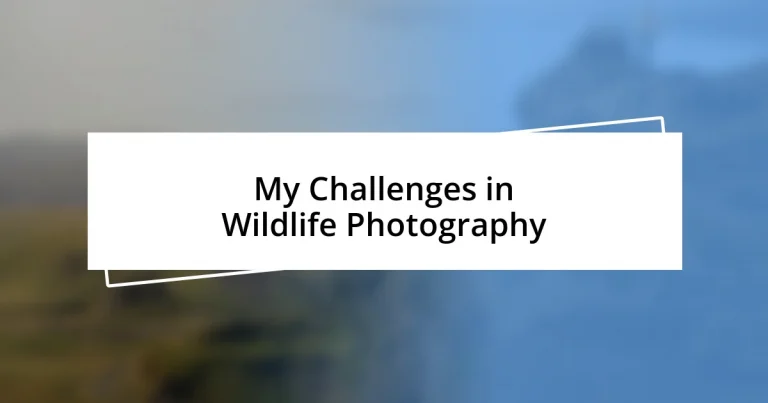Key takeaways:
- Wildlife photography involves deep connection with nature and requires patience and readiness for unexpected moments.
- Understanding wildlife behavior, timing, and proper gear are essential for capturing impactful photographs.
- Environmental challenges can be transformed into unique opportunities and artistic advantages in photography.
- Building patience and persistence is vital; the journey can often be as rewarding as the photographic outcomes.

My Journey in Wildlife Photography
My journey in wildlife photography began quite unexpectedly during a family trip to a nature reserve. I remember crouching in the underbrush, my heart racing as a deer stepped into view. It struck me then—being behind the lens was more than capturing images; it was about connecting with nature on an intimate level. Have you ever felt that rush when you first spot a wild creature? It’s like tapping into a secret world.
As I ventured deeper into the wilderness, I faced numerous challenges that tested my patience and skills. One particularly memorable moment was when I spent hours waiting in the early morning mist for a glimpse of nesting birds. The chilly air reminded me how nature often doesn’t show its wonders easily. Have you ever had to wait for something precious that felt like it might never happen? When that moment finally arrived, and I captured the delicate chicks being fed, I felt a sense of triumph that was absolutely thrilling.
Over the years, I’ve learned that every wildlife excursion brings its own set of lessons. I once missed capturing an elusive fox because I was too focused on adjusting my settings. It was frustrating, but it taught me to be present and ready at all times. Isn’t it incredible how such moments can shift your perspective? Each outing has refined my approach, reminding me that in the realm of wildlife photography, sometimes the best shots are the ones you least expect.

Understanding Wildlife Behavior
Understanding wildlife behavior is crucial for a successful photography experience. I recall an instance when I witnessed a herd of elephants feeding. Watching their interactions gave me a glimpse into their social hierarchy and respect for their young. I realized then that understanding their behavior can mean the difference between a fleeting snapshot and a meaningful photo that tells a story.
Observing wildlife requires patience and awareness of their patterns. Here are some key insights I’ve gathered:
- Time of day matters: Animals are often most active during dawn and dusk, making these the best times for capturing rich, dynamic photos.
- Weather influences behavior: Rain can awaken nocturnal animals, while sunny days might see them retreating for shade.
- Know the territory: Understanding the terrain helps predict animal movements, increasing your chances of a perfect shot.
- Respect their space: Observing from a distance fosters natural behavior, leading to more authentic photographs.
- Vocalizations matter: Listening to the sounds around you can help identify what animals are nearby and what they might be doing.
The more I’ve observed, the clearer it became that understanding wildlife was not just about knowing facts; it was about feeling a genuine connection to these magnificent creatures.

Essential Gear for Wildlife Photography
Choosing the right gear for wildlife photography is crucial to capturing those breathtaking moments in nature. From my experience, a good camera with fast autofocus is essential, especially in situations where animals move quickly or unexpectedly. I once had my trusty DSLR with a telephoto lens ready during a safari when a pride of lions passed by. That moment confirmed for me how vital it is to have equipment that can keep pace with wildlife.
Another consideration is the tripod. While it may seem cumbersome to carry, a sturdy tripod can significantly improve stability during long shoots. I learned this lesson the hard way while trying to photograph birds in low light without one. The resulting shaky images reminded me that sometimes the simplest piece of equipment can make the highest quality difference in capturing sharp shots.
Finally, don’t overlook the importance of proper clothing and accessories. I always pack lightweight, water-resistant gear that allows me to blend into the environment. One rainy day while photographing a river otter in a marsh, my camouflaged outfit helped me remain unnoticed. It’s these little details that create a more immersive wildlife photography experience.
| Gear Type | Description |
|---|---|
| Camera | Fast autofocus and good performance in low light. |
| Lens | Telephoto lens for distant wildlife shots. |
| Tripod | Essential for stability, especially in low-light conditions. |
| Clothing | Lightweight and water-resistant; helps you blend with the environment. |

Overcoming Environmental Challenges
There’s something breathtaking about being immersed in nature, yet it often brings unforeseen environmental challenges. For instance, I remember one particularly windy day in a coastal region; the gusts were strong enough to topple my setup. My lens was struggling to focus amid the swaying grass, and I felt frustration creeping in. But I paused, realized that burrowing in and exposing my kit to less wind would improve my shot. Adapting to the elements can sometimes be the key to capturing that perfect moment.
Then there are the unpredictable changes in weather. During a planned outing to photograph a migratory flock, the sky unexpectedly darkened, and rain began to pour. At first, I thought my day was ruined, but I adapted; I sought shelter under a nearby tree and waited. Surprisingly, as the rain softened, the birds emerged, shaking off the droplets, and I captured some of the most stunning images of the day. Isn’t it fascinating how challenges can lead to serendipitous opportunities?
When it comes to working in diverse environments, I’ve often found myself adjusting my mindset. A recent trip to a dense forest took more patience than I had anticipated. The thick underbrush blocked sunlight, making the setting moody and dark. Instead of getting disheartened, I leaned into the unique atmosphere, focusing on low-light techniques. I ended up with an enchanting series of silhouettes, and it drove home the point that embracing environmental hurdles can unveil hidden beauty. Isn’t it exhilarating how we can transform obstacles into artistic advantages?

Mastering Lighting and Composition
Mastering lighting and composition is truly the backbone of wildlife photography. I’ve often found myself wishing for that golden hour light, when everything seems to glow. One time, while waiting for a group of elephants to cross a river at dawn, I realized how the soft light enhanced every detail, from the gleam on their wet skin to the subtle hues in the sky. It made me appreciate how timing can elevate an image from ordinary to extraordinary.
Composition plays a critical role too. I remember a moment when a majestic eagle swooped down in front of me. Initially, I framed the shot based on instinct, but just before snapping, I paused to think about the rule of thirds. By repositioning slightly, I was able to place the eagle off-center with the expansive landscape behind it. That small adjustment transformed the photo; it felt more dynamic and engaging. Have you ever thought about how a slight shift in perspective can change the story your image tells?
Sometimes, working with natural light can feel like you’re dancing with shadows and highlights. There was one day when I ventured out in harsh midday sun to photograph a group of wildebeest. Instead of being discouraged by the strong contrast, I sought out shaded areas under acacia trees. Doing so created softer lighting conditions, enhancing the textures in their coats and bringing out their personality. This experience taught me that mastering the light isn’t about fighting against it; instead, it’s about understanding and embracing it. Isn’t it fascinating how the same scene can look entirely different based on how we choose to interpret the light?

Tips for Capturing Great Moments
Capturing great moments in wildlife photography often hinges on being ever-present in the moment. I recall one afternoon while tracking a troop of monkeys; I was impatiently waiting for the perfect shot. Suddenly, one playful little monkey swung directly overhead, and instinctively, I raised my camera. The unexpected nature of the encounter resulted in a photo bursting with energy and joy. Isn’t it exhilarating to realize that sometimes, the best moments come when we least expect them?
Being patient is just as essential as being present. Not long ago, I sat quietly near a watering hole, observing the subtle movements of the animals around me. Hours passed without much action, but then, a herd of antelope emerged, cautiously approaching for a drink. The anticipation heightened my excitement, and when they finally stepped into the soft light, I felt a rush of adrenaline as I clicked away. How often do you find that good things come to those who wait?
I’ve also learned to tap into my intuition when it comes to capturing emotions. During an early morning trek, I came across a lioness cradling her cubs. That moment felt sacred; I could almost sense the bond between them. Instead of rushing to capture it all, I took a moment to breathe and focus my lens. The resulting images conveyed so much raw emotion, revealing the deep connection that words often fail to express. Have you ever considered how a single moment can weave a powerful narrative through your lens?

Building Patience and Persistence Skills
Building patience and persistence skills is like nurturing a seed; it takes time to grow, but the results can be breathtaking. I remember a day spent in a dense fog while waiting for a roe deer to emerge from the thicket. My initial excitement quickly turned to frustration as the minutes ticked away. However, I learned that sitting quietly, embracing the stillness, allowed me to absorb the beauty around me. It was in that moment of waiting that I truly connected with the landscape. Have you ever realized that the actual process can be just as fulfilling as the outcome?
Each time I face delays or unforeseen circumstances, I remind myself that persistence is key. I once trekked for hours through thick bush, trailing a family of cheetahs. When I finally lost sight of them, I had two choices: give up or keep pushing forward. I chose the latter, knowing that patience often leads to unexpected rewards. Eventually, I found them lounging under a tree, and that moment, after so much effort, became one of my favorite captures. Doesn’t it feel wonderful to see your hard work pay off, especially in a fleeting moment like that?
The emotional toll of waiting can be overwhelming, yet I’ve found it often transforms into pure joy when a long-awaited sighting arrives. I think back to a chilly morning spent watching a pod of dolphins swim close to the shore. After what felt like hours of watching nothing but waves, the moment they leaped into the air took my breath away. That thrill reminded me that patience is not simply about waiting, but about how we react to the moments that unfold. Have you experienced that switch from anticipation to exhilaration? It’s this journey of building patience and persistence that enriches our stories as wildlife photographers.














